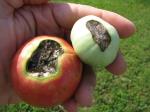COLUMBIA, Mo. – Your beautiful tomato plant is setting fruit and soon has nice green tomatoes. Then, to your horror, a dark, sunken spot shows up at the bottom of the fruit. You might think an insect or disease has attacked your plant. But that’s not the case. It’s actually a physiological disorder called blossom-end rot that is caused by a calcium imbalance.
Plant cells have rigid cell walls. To build those walls, the plant needs calcium.
“Calcium is to cell walls what the cement is in a brick wall. It gives it structural strength,” said David Trinklein, horticulture specialist for University of Missouri Extension.
After being taken up by the roots, calcium moves through the plant in the vascular tissue via “mass flow.” The latter requires water, Trinklein said. If there isn’t enough water to carry the calcium or enough calcium to be carried by the water, then the mineral cannot reach the distal (blossom) end of the fruit, and those walls break down. The result is a dark, sunken spot.
One of best ways to control blossom-end rot is to test the soil before you plant your tomatoes.
“In most Missouri soils, if the pH is at the ideal level of 6.2-6.5, there likely is sufficient calcium in the soil,” Trinklein said. If a soil test shows the pH is fine but the soil still needs calcium, then adding something like calcium sulfate, also called gypsum, will boost the calcium levels without changing the pH.
In Missouri, improper watering typically causes blossom-end rot, he said. With all the rain this year, our tomato plants are nearly drowning.
“Oddly enough, a plant that is overwatered has difficulty taking up water,” Trinklein said. “It’s called water wilt.”
When plants are standing in water, their roots don’t get enough oxygen. This damages the cell membranes and the roots can’t take up sufficient water to deliver needed calcium to the fruit.
Poor soil and improper watering aren’t the only causes of blossom-end rot. We can also cause it by damaging the roots while weeding. If the root system is damaged, it cannot take up sufficient water and calcium.
“You will find that gardeners who get a new rotary tiller will often have blossom-end rot,” Trinklein said. “They cruise up and down the rows churning the soil with their new toy, which frequently results in excessive root pruning.”
Fertilizing tomatoes incorrectly can cause the disorder too. Trinklein says there are two forms of nitrogen that can be taken up by the plant: ammonium form, which has a positive charge, and nitrate form, which has a negative charge. He says the nitrate form is preferable for tomatoes.
“If we feed excessive amounts of ammonium-form nitrogen to tomatoes, its positive charge confuses the plant because calcium has a positive charge. We call that nutrient antagonism,” Trinklein said. “Ammonium will keep the plant from taking up adequate calcium.”
Avoid urea fertilizer, which converts to ammonium form, he said. Many products sold as tomato fertilizer contain urea, so be sure to read the label.
An ideal fertilizer to feed tomatoes is calcium nitrate, Trinklein says. We’re giving the plant the nitrate it wants, and as we’re doing so, we’re adding some calcium to counter blossom-end rot.
The MU Extension guide “Growing Home Garden Tomatoes” (G6461) is available for free download at http://extension.missouri.edu/p/G6461.
Soil tests for lawns and gardens are available for a nominal fee through MU Extension’s Soil and Plant Testing Laboratory. For more information, go to http://soilplantlab.missouri.edu/soil.
For more information from MU Extension on lawn and garden topics, including downloadable guides, articles and online resources, go to http://extension.missouri.edu/LawnGarden.
Read more http://extension.missouri.edu/news/DisplayStory.aspx?N=2555





